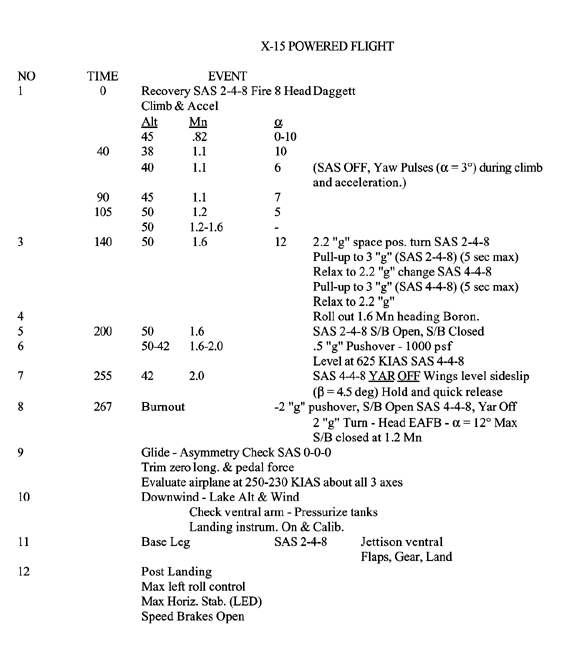
Launch Evaluation
.82 Mach at 45,000 ft., dampers on 2-4-8.
II.
Climb and accelerate to M = 1.2 at 50,000 ft on the heading shown in space positioning chart using the following schedule.

III.
M 1.1 - 1.6, Altitude
40 - 50,000 ft.
After recovery from launch at M = 1.1 at 40,000 ft. and during the ensuing climb to 50,000 ft. and acceleration to 1.6 M, execute alternately yaw pulses (b = 3°) and pitch pulses (·g = 1). (With all dampers off.)
IV.
Space Positioning Turn
B. During this turn pullup to 3 g's at SAS settings of 2-4-8 and 4-4-8. Do not exceed 5 sec. for each pull-up and return to 2.2 g's.
C. In this turn, adjust normal acceleration to maintain approximately 1.6 M rolling out on the magnetic heading of 295 degrees.
Speed Brake Evaluations
1.6 M at 50,000 ft. SAS = 2-4-8.
On rolling out of the 2.2g windup turn cycle the speed brakes through full deflection and retract.
VI.
Pushover to .5g and accelerate to M2 at 47,000 ft. a = 2.3°, q = 800 psf, IAS = 565 Kn.
VII.
Level Flight Run
at M = 2 at 47,000 ft.
With SAS at gain settings of 4-4-8, perform a wings level sideslip to max vertical stabilizer deflection (b = 4.5°). This maneuver should be performed with a max rate input, hold, and a quick release after steady sideslip has been established.
VIII.
At burnout perform a -2g pushover followed by a speed brake extension to full deflection.
IX.
With the speed brakes fully extended initiate a 12° angle of attack turn to Rogers Dry Lake closing the speed brakes at approximately M = 1.2.
X.
In the subsonic
glide back to base perform the following maneuvers.
A qualitative evaluation of the airplane about all three axes at 250 and 230 knots indicated air speed, SAS = 0-0-0.
XI.
Perform the landing maneuver.
Hold controls as described for entire ground slide, space permitting.

